Synthetic Counter (iGem2005 ETH Zurich)
From 2006.igem.org
Christophe (Talk | contribs) |
Christophe (Talk | contribs) (→Design of the Counter) |
||
| Line 9: | Line 9: | ||
The counter u | The counter u | ||
| - | [[Image:Overview_Counter]] | + | [[Image:Overview_Counter.png]] |
To counter is made of two parts, serially linked: | To counter is made of two parts, serially linked: | ||
| Line 21: | Line 21: | ||
==Input Module== | ==Input Module== | ||
==NOR Module== | ==NOR Module== | ||
| + | |||
=Simulation= | =Simulation= | ||
=Implementation= | =Implementation= | ||
=Results and Discussion= | =Results and Discussion= | ||
=Applications and Perspecitves= | =Applications and Perspecitves= | ||
Revision as of 08:38, 15 October 2005
Abstract. We report here the design and implementation in vivo of a gene circuit that can count up to 4. In essence, it uses two toggle switches, each storing 1 bit, to keep track of the 4 states. The design of the counter is highly modular, with the hope that it can be included as a unit in larger circuits, and also combined with further counter instances to keep track of a much larger number of states, up to (2^(n+1)) with n units. To facilitate further developments and integration to other projects, the counter is available in form of BioBricks. Among many exciting applications, the availability of a counter enables the execution of sequential instructions, and paves the way for the execution of artifical programs inside living cells.
Contents |
Introduction
The past few years have seen the emergence of the field of synthetic biology, in which functional units are designed and built into cells to generate a particular behaviour, and ultimately to better understand Life's mechanisms. Previous efforts include the creation of gene circuits that generate oscillating behaviour (Elowitz00), toggle switch functionality (Atkinson03), artificial cell-cell communication (Bulter04) or pattern-forming behaviour (Basu2005). The present document describes the design and realization of a gene circuit that counts to 4.
Design of the Counter
The counter u
To counter is made of two parts, serially linked:
- the "Input" module, which splits the input into two opposite signals.
- the "NOR" module, which keeps track of the changes in those signals.
The design of both parts has been made using the [http://partsregistry.org/cgi/htdocs/AbstractionHierarchy/index.cgi abstraction hierarchy] developped by the team of the MIT Registry of Parts, in particular using the concept of polymerase per second ("PoPS") as metric for all interfaces.
